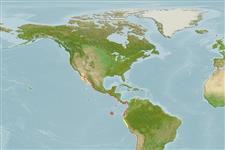Environment: milieu / climate zone / depth range / distribution range
Ecología
marino; agua dulce; salobre demersal; rango de profundidad ? - 36 m (Ref. 9330). Tropical; 32°N - 18°S, 115°W - 71°W
Eastern Pacific: Gulf of California to Peru.
Tamaño / Peso / Age
Maturity: Lm ? range ? - ? cm
Max length : 27.9 cm TL macho / no sexado; (Ref. 124487); common length : 20.0 cm TL macho / no sexado; (Ref. 9330); peso máximo publicado: 258.00 g (Ref. 124487)
Radios blandos dorsales (total): 76-89; Radios blandos anales: 57 - 68; Vértebra: 33 - 35
Found on soft bottoms of trawling grounds and bays (Ref. 11482); commonly found in estuaries; sometimes enters freshwater. Feeds on big benthic invertebrates and small fishes. Utilized fresh and frozen.
Life cycle and mating behavior
Madurez | Reproducción | Puesta | Huevos | Fecundidad | Larva
Distinct pairing (Ref. 205).
Hensley, D.A., 1995. Paralichthyidae. Lenguados. p. 1349-1380. In W. Fischer, F. Krupp, W. Schneider, C. Sommer, K.E. Carpenter and V. Niem (eds.) Guia FAO para Identification de Especies para lo Fines de la Pesca. Pacifico Centro-Oriental. 3 Vols. FAO, Rome. (Ref. 9330)
IUCN Red List Status (Ref. 130435)
Threat to humans
Harmless
Human uses
Pesquerías: escaso valor comercial
Más información
ReferenciasAcuiculturaPerfil de acuiculturaRazasGenéticaElectrophoresesheritabilidadEnfermedadesProcesamientoNutrientsMass conversion
Herramientas
Special reports
Download XML
Fuentes de Internet
Estimates based on models
Preferred temperature (Ref.
123201): 20.4 - 29, mean 25.9 °C (based on 263 cells).
Phylogenetic diversity index (Ref.
82804): PD
50 = 0.5000 [Uniqueness, from 0.5 = low to 2.0 = high].
Bayesian length-weight: a=0.00741 (0.00325 - 0.01693), b=3.15 (2.97 - 3.33), in cm total length, based on LWR estimates for this Genus-body shape (Ref.
93245).
Nivel trófico (Ref.
69278): 4.1 ±0.63 se; based on food items.
Generation time: 0.9 ( na - na) years. Estimated as median ln(3)/K based on 1
growth studies.
Resiliencia (Ref.
120179): Alto, población duplicada en un tiempo mínimo inferior a 15 meses (Preliminary K or Fecundity.).
Fishing Vulnerability (Ref.
59153): Low vulnerability (15 of 100).
